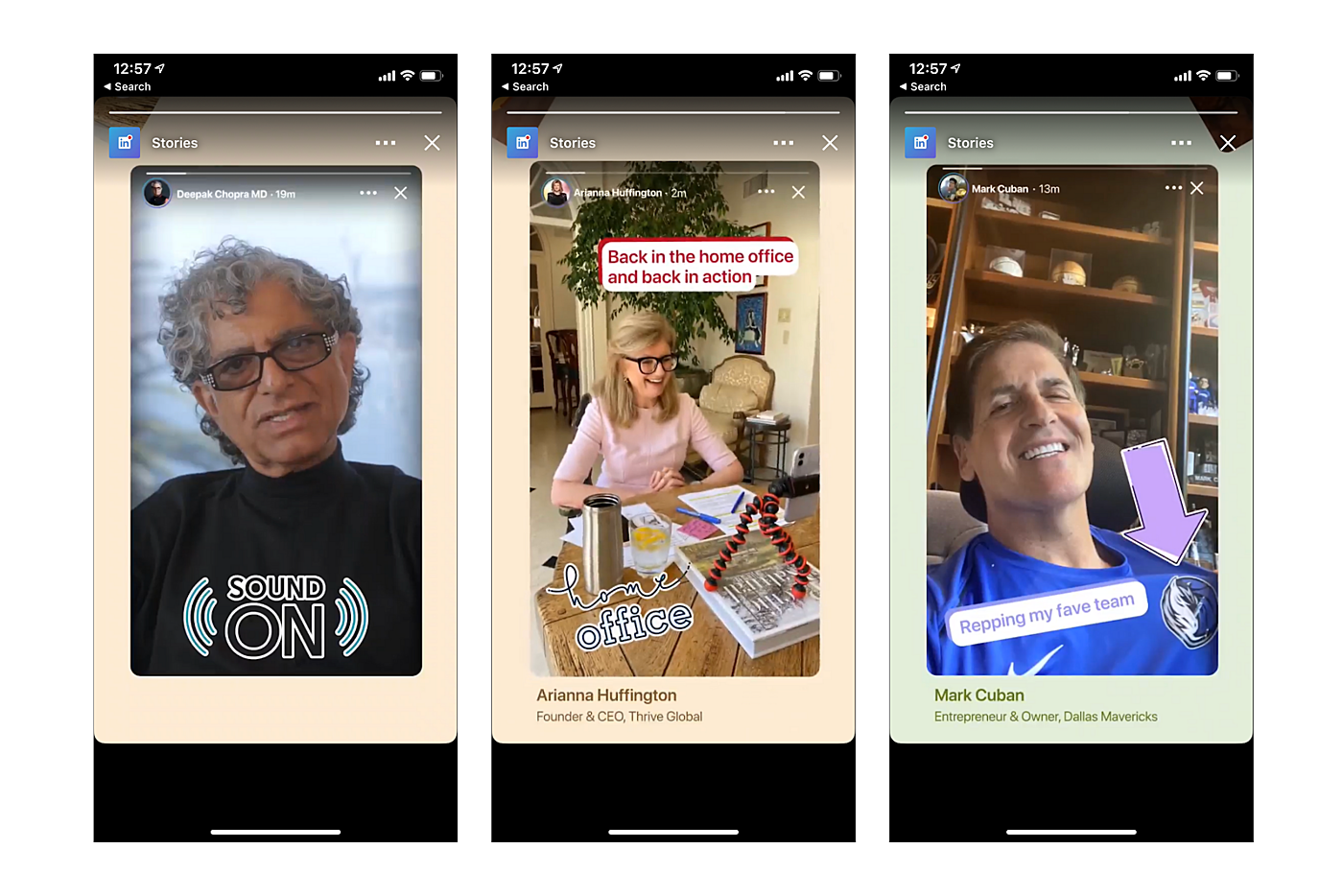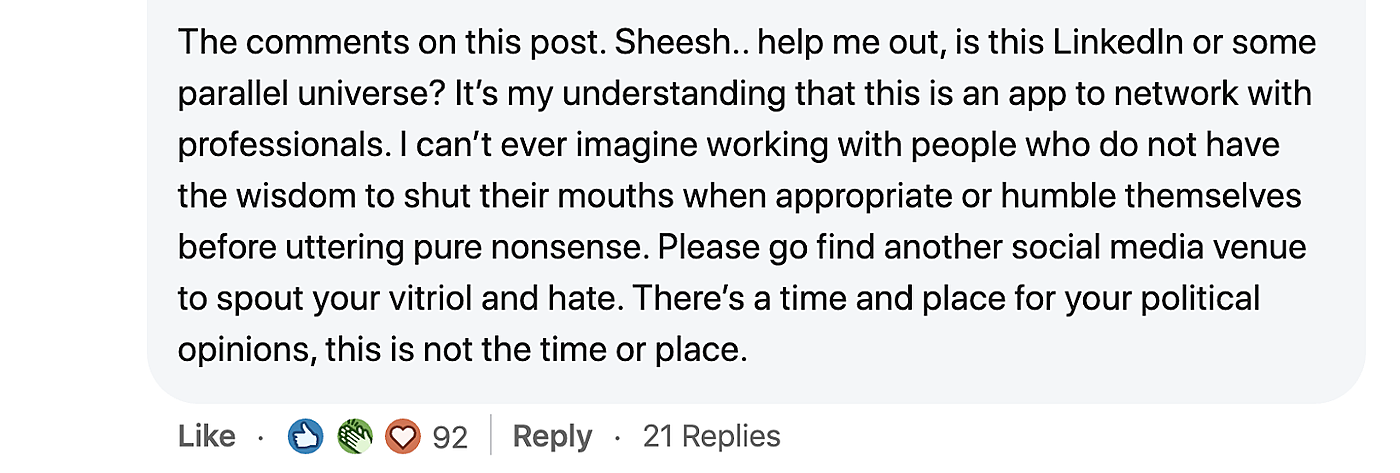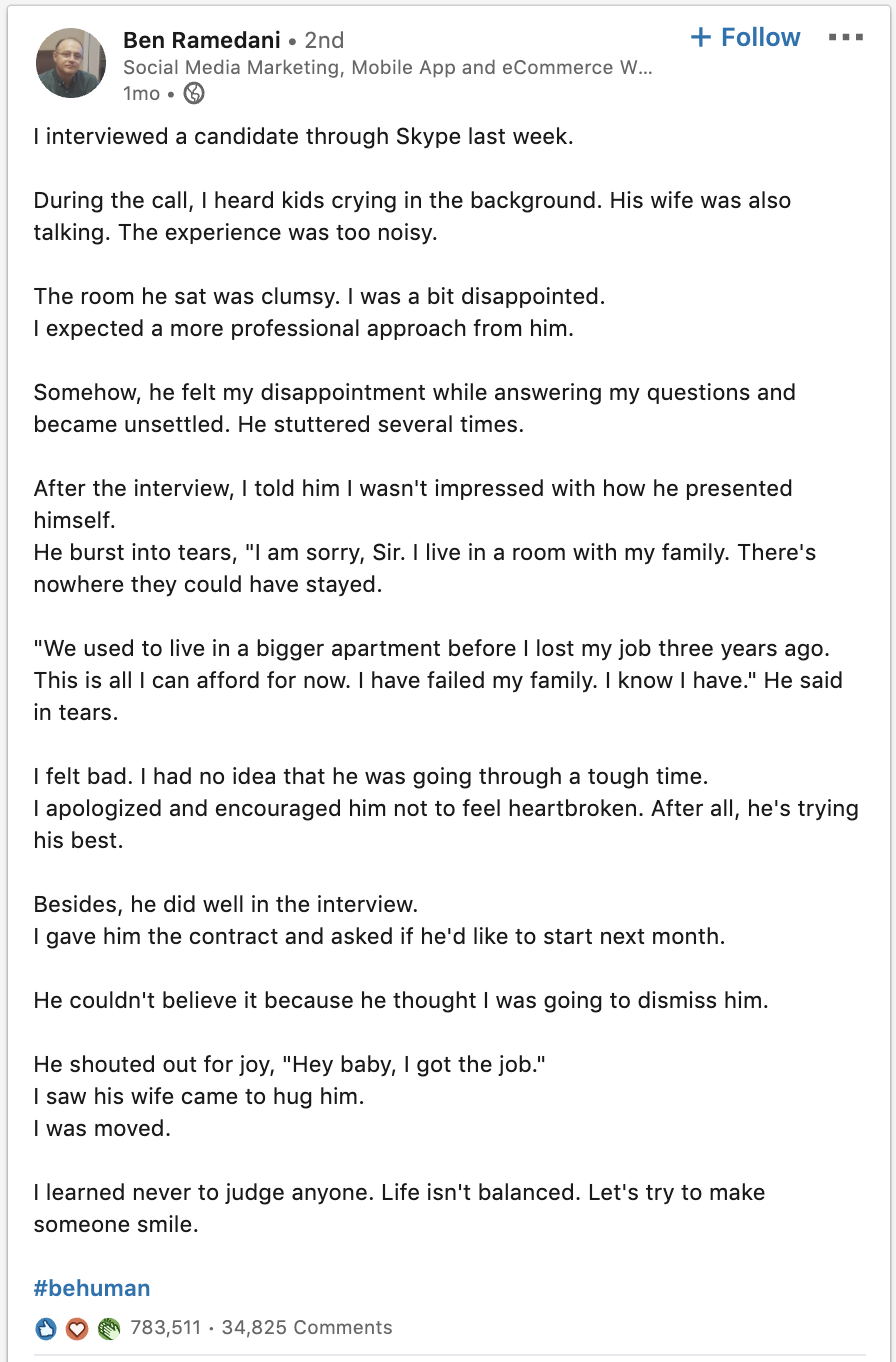
Hey! Today I have something different for you. It’s a piece about the weird world of LinkedIn — from celebrity workfluencers to the strange social features that feel out of place. This is a guest essay from Fadeke Adegbuyi, senior marketing manager at Doist and a fan of all things internet culture. I think you’re going to like it! 😆
- Nathan
LinkedIn is the fucking worst.
Despite our collective confusion about the platform, its enthusiastic embrace by HR departments and recruiters has ensured its success. Even though it was forced to lay off 1,000 employees because of the pandemic, they still increased their Q4 revenue by 10%. As of Q3 of 2020, the company has over 722 million users and is truly international––just 26% of their members are based in North America. With revenue largely powered by recruiting solutions, paid job listings, and advertising, LinkedIn knows how to appeal to businesses at scale. LinkedIn doesn’t need you to like it.
But, the company’s consumer-side remains in the midst of a long-standing identity crisis. Feature bloat and odd idiosyncrasies make the site a superbly strange social network. Many of us have profiles but don’t log in for months at a time. Our “About” sections point to better ways to be reached. Others, seemingly alive and well, have claimed on their pages to have died.
LinkedIn bills itself as an online destination, like a conference held at a 5-star hotel where big thinkers give big speeches, deals get made in private corners, and you can “build and engage with your professional network.” But many of us see it as a not-so-funhouse, with wacky mirrors, jumpout surprises, and peculiar attractions. Can I interest you in a tour?
Copy-Cat Cemetery
LinkedIn recently released Stories, a vertical video feature copied from Instagram, who better stole it from Snapchat. LinkedIn suggests users “share images and short videos of their everyday professional moments.” Released in the midst of a global pandemic during a mass migration to remote work, it’s unclear whether we should showcase cramped work setups on kitchen tables or restless kindergarteners interrupting the 143rd minute of a Zoom.
Available only on LinkedIn's iOS and Android apps, this begs the question...Who is using LinkedIn on their phone? The platform would like you to believe that celebrities are. A permanent Story from LinkedIn shows a reel of workfluencers ––Mark Cuban, Arianna Huffington, Deepak Chopra –– posting professionally shot high-definition videos of their work days.
A tagline ends the montage: “Share your story.” At last glance, only a single one of my 1000+ connections is using the feature.
In contrast, Twitter is seeing early success with Fleets, their own copy-cat story feature that users have been receptive to, posting baby photos and dog pictures in between subtweets and shitposts. Feature imitation isn’t a bad strategy. But LinkedIn Stories was dead on arrival. No one in the boardroom asked the critical question: Who cares?
The Audio Trolls
Audio apps, like Clubhouse, Chalk, and Rodeo point to the power of sound-based social. Twitter released voice tweets earlier this spring and is currently working on an audio spaces feature. LinkedIn has taken their own steps into voice with a handful of audio features. Like most things on the platform, they feel out of place.
The sentiment behind their name pronunciation feature on personal profiles is a positive one, but hasn’t seen wide adoption for its intended purpose. Since the feature was launched, I’ve heard people with the most pronounceable of names use the feature for anything from inserting a 10-second clip from The Office to playing a song snippet at 2x speed. A now common but unintended use case is delightful trolling:
- At one point, Jeff Hui used the feature to ironically shout an elevator pitch at recruiters
- On Riva-Melissa Tez’s profile, she declares herself “Queen Bee”
- Ben Taylor, who includes “click 4 sound” in his name, rickrolls his profile visitors
On a site where people declare Ivy League associations, summa cum laude status, and internships at investment banks, cheeky irreverence for work culture warps the throughline of respectability that LinkedIn intends. Trolling LinkedIn, while on LinkedIn, is a break from the BusinessTM of polished headshots and corporately crafted “Experience” sections. It’s ironic participation on a platform where you’re meant to be performing professionalism.
At times, it feels like LinkedIn is actively building features for the intended purpose of trolling. Within LinkedIn messages, users can hold down a microphone icon to record their voice. An audio snippet is an oddly intimate option for starting a professional conversation with a stranger. Perhaps that’s the point. But attempting to speed up relationships with overly familiar features is a “personal touch” unwelcome in the world of networking, already so fraught with faux pas.
An innocent but outlandish 39-second audio message, sent by “Jimmy from LinkedIn” went viral as a case of networking-gone-not-quite-right:
“Hello Candice, how are you doing and good morning. How have you been? Hey Candice, this is me, Jimmy from LinkedIn. And the reason I was giving you this quick voice message call was to say thank you so kindly. I really appreciate that you have accepted me here on the LinkedIn platform. What we will do is learn from each-other. I appreciate your kindness. Jimmy from LinkedIn.”
Though it doesn’t feel malicious, it’s just off to encounter this kind of weirdness in the same space you seek new job opportunities and professional updates from former colleagues and classmates. It’s the stuff that makes you pause and say, Where am I?
InMail Infinity
The premise of the platform, bringing professionals together, is a challenging one from the start. People hate networking. Also, they’re bad at it.
For users, LinkedIn “networking” often means receiving a barrage of InMail and connection requests. You might recognize some or all of these:
- The bad sales pitch: Sales people and business development people will slide into DMs to peddle their company’s products, whether you’re the right person to buy or not. Usually not.
- The professional neg: Recruiters ask senior level employees if they’re interested in entry level roles or, better yet, internships.
- The just-in-case connection: Industry peers will suggest it’s “mutually beneficial” to connect, but don’t specify these benefits up front.
- The endangered business school: Admissions teams are now online shilling once-coveted seats in their dwindling MBA programs. Based on your profile and experience, they think you’re a “great fit” and want you to apply.
- The eager seeker: Some people see LinkedIn messages as an alternative resume and cover letter submission portal. This is why that endless string of people in your messages inquire about roles outside your department… or outside your company.
- The LinkedIn team: If their emails notifying you about connection requests wasn’t enough, LinkedIn also maintains a direct line to your InMail. Expect prompts to try Premium, credits to advertise your company, and messages about whatever else they’re feeling.
- The proposition: Linkedin stands in the long-tradition of every site becoming a dating site. Or, er, a place to sexually harass people. If you haven’t gotten one of these messages in your InMail, you know someone who has.
Overfull InMail and random connection requests feels like a never-ending chore. You get enough work emails and don’t need any more. LinkedIn’s constant drip of communication is just more work on top of the real work you have to do.
Linkedin’s inbox infinity isn’t just annoying—it detracts from the usability of the platform. Unless you’re embracing a new position of processing and answering everything that comes through, if a real connection came along, how would you know?
The Cursed Timeline
At any given point on your LinkedIn timeline, you’ll see a corporate blog post shared by someone you know, a marketing sales pitch from someone you don’t, and a news story about COVID-19. Their timeline is similar in this way to other social networks, where you see posts made or liked by your connections, people and brands you follow, and promoted posts that people pay to get in front of you. This cacophony of content is bizarre, but not atypical –– social feeds optimize for engagement, here as everywhere.
What’s uniquely odd about LinkedIn is that it is not unique. “The professional network” is still just a social network. Though the topics of the posts in your timeline may be on the world of work, diving into the comments, you can see polarization in action. Inspirational posts on giving parents grace while working from home during the pandemic have angry rants suggesting that kids are a personal choice and their burden shouldn’t be foisted upon colleagues. Beneath articles on workplace harassment, sympathetic discussions ensue on why someone might naturally retaliate after being romantically rebuffed. A political article about the 2020 US presidential election draws comments on whether former President Barack Obama was really Black.
In a time when the collective conversation is consumed by the topic of human cancellation, people readily post things on LinkedIn that make them fireable or unhireable.
While these comments are nothing new in terms of online culture, they feel out of bounds on a professional website where people use their full names and disclose precisely where they work and the city they live in. In the alternate universe of LinkedIn, cancel culture either doesn’t exist, its inhabitants are blissfully unaware, or they simply don’t care.
The Rockstar Recruiters
The strangest of Linkedin’s features isn’t a feature at all; it’s a specific set of power users.
Every platform has its royalty. On Instagram it's influencers, foodies, and photographers. Twitter belongs to the founders, journalists, celebrities, and comedians. On LinkedIn, it’s hiring managers, recruiters, and business owners who hold power on the platform and have the ear of the people. The depravity of a platform where HR Managers are the rockstars speaks for itself.
On a job site, they’re the provisioners of positions and never miss the chance to regale their audience with their professional deeds: hiring a teenager with no experience, giving a stressed single mother a chance to provide for her family, or seeing past a candidate’s imperfections to give them a once-in-a-lifetime opportunity. These stories are relayed dramatically in what’s now recognizable as LinkedIn-style storytelling, one spaced sentence at a time, told by job-givers with a savior complex.
On LinkedIn, jobs are not a trade between an individual and a corporation, or a way to fill the space between 9 to 5. On LinkedIn, jobs are life-affirming or life-saving opportunities, rescuing people from a life of meaningless toil or imminent ruin.
In this story, straight from the weird world of LinkedIn, people use Skype in 2020, hiring managers give unsolicited feedback on performance at the end of an interview, and contracts are flourished and signed immediately. Readers get everything they would ever want out of a story in under 250 words: conflict, a tragic confessional, a change of heart, a happy ending, and a valuable lesson on how to #behuman.
In the age of infinite entertainment and peak television, over 783,438 people were moved to leave a reaction on a story that’s probably not true.
And yet, the comments underneath reveal a depth of sincerity, divine blessings, and extended admiration. Imitation is flattery and this story was so compelling that dozens of people have stolen and co-opted it, hoping for their own viral moment. LinkedIn doesn’t market itself as a place for “quick bites,” but feeds are overflowing with these types of stories each day, and they capture attention—both on the platform and off.
Taken out of context of the LinkedIn cinematic universe and shared on Twitter, these stories are a point of derision rather than admiration, and inspire parody more than parroting, underscoring the differences between LinkedIn and other social platforms.
LinkedIn story-telling, driven by Rockstar Recruiters and other job provisioners, has evolved, as work has evolved. Browsing LinkedIn several years ago revealed the same line-by-line storytelling, but anecdotes that were thematically different. Then, the pendulum of storytelling swung toward hustle culture. Timelines were filled with team-building entrepreneurs doing their best Gary Vaynerchuk impression, imploring their followers to work more, try harder, and eat shit to get ahead.
Recruiters were gatekeepers who used LinkedIn to share the best ways to lose access to them and get your resume thrown in the digital dustbin. While this brand still exists on the platform, it’s dwarfed by the new era of micro storytelling—empathy is trending. Now, the platform’s viral stories are about “bringing your whole self to work,” self-care, and finding work-life balance in a busy world. In light of how work has changed because of the pandemic, micro storytellers instruct us on having compassion for colleagues behind the screen, and the dangers of burnout with remote work.
Given the accompanying economic downturn and the increased pressure when it comes to job searches, recruiters are selling HR as friends of the downtrodden, willing to look past less job experience and unbrushed hair when it comes to assessing candidates and giving them the coveted offer letter. In fact, they even prefer it! In the Land of LinkedIn, the young, hungry, and stupid are always better bets than the polished, professional, and competent. LinkedIn is filled with these stories about work –– real, exaggerated, and imagined.
Reduced to its simplest form, LinkedIn is a digital resume. A profile consists of your past work experience, education, skills, and references. The posts, comments, and messages are like a cover letter. But we’ve long decided that there are better ways to showcase your ability than a list of the places you’ve worked, the school you went to, and a hastily drafted plea for work. Resumes are old scrolls of a bygone era. If LinkedIn is a site meant to demonstrate you’re an expert, it’s competing against all the places you can do this better.
Developers have GitHub, designers use Dribbble, and Academics maintain their ResearchGate or Google Scholar profiles. There’s Twitter, where an ethos of entertainment first, professionalism second makes “networking” more natural and even more effective. Plus, there’s personal websites and portfolios. Everyone is building a personal brand, they’re just not doing it on LinkedIn.
The professional platform doesn’t quite work because it's a collection of contradictions. It's the site with millions of users that nobody you know uses. It’s where you put your resume, but never apply for a job.
And yet, many of us have a profile and might even maintain it, adding a new role when we make a professional move. We may venture into InMail Infinity, not knowing whose invite to accept and in the end accepting them all. Some of us even “like” updates from promoted friends and former colleagues who are also performing professionalism, probably just as ambivalent about the platform as we are. Keeping our page current, skimming messages, and doing the very least to ensure our network doesn’t forget us is a “just-in-case” mentality powered by some level of professional anxiety.
If you have a job, you might lose it. If you don’t, you might find one.
So, we stay. Even if it sucks.
LinkedIn is bizarre because it tries to make this hostage situation fun. Even though it’s not. Not when you add stories, audio messages, DMs, a social feed, or anything else. The platform might be less alternate universe and more down to earth if the truth was acknowledged: performative professionalism, job hunting, and networking are extensions of work not play. As long as LinkedIn pretends otherwise, we can also pretend that we’ll never be desperate enough to use it in earnest.
Fadeke Adegbuyi is a senior marketing manager at Doist and a fan of all things internet culture.
Like this?
Sign up to get notified when Fadeke’s next essay drops
The Only Subscription
You Need to
Stay at the
Edge of AI
The essential toolkit for those shaping the future
"This might be the best value you
can get from an AI subscription."
- Jay S.
Join 100,000+ leaders, builders, and innovators

Email address
Already have an account? Sign in
What is included in a subscription?
Daily insights from AI pioneers + early access to powerful AI tools
































Comments
Don't have an account? Sign up!
The author seems to be arguing that the problem with LinkedIn is that it is a little awkward in places and does not have the insanely addictive features common to other social media platforms. I'd argue that the former quality makes it a lot like the working world in general, and the latter quality, after seeing what social media platforms have inflicted on us the past few years, is a welcome relief. Sure, I don't check LinkedIn that often and I don't access it all the time on my phone. That's not a bug, that's a feature.